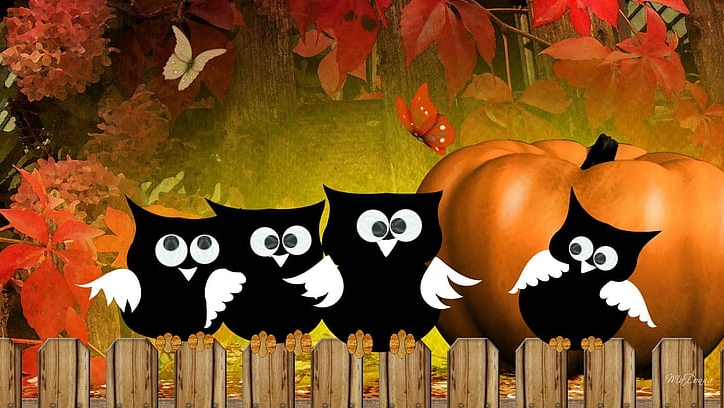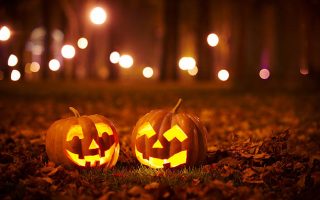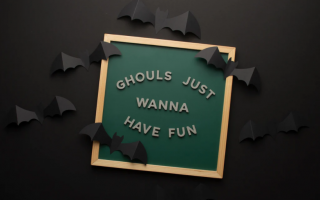Owls have long been enigmatic creatures of the night, captivating human imaginations with their mysterious demeanor and haunting calls.
This fascination with owls has extended into the realm of folklore and mythology, where they have become symbolic of various cultural beliefs and superstitions.
One of the most notable associations that has developed over the years is the connection between owls and Halloween, a holiday steeped in its rich traditions and symbolism.
But why are owls linked to this spooky celebration, and what is it about these birds that makes them such an iconic Halloween symbol?
In this article, we will delve into the intriguing history and symbolism behind the association of owls with Halloween, shedding light on these nocturnal creatures’ dark and enigmatic allure within the context of this eerie and festive holiday.
Historical Context
The association of owls with wisdom, mystery, and the supernatural dates back to ancient civilizations, and some of the earliest and most well-known references come from the Greeks and Romans.
Greece – Athena’s Owl
In ancient Greece, the owl was closely connected to the goddess Athena, the deity of wisdom, courage, and strategic warfare.
Athena was often depicted with an owl perched on her shoulder or accompanying her.
The owl, known as the “Little Owl” (Athene noctua), became a symbol of wisdom and insight due to its ability to see in the dark and its calm, observant nature.
Athenian silver coins even featured the image of the owl, reinforcing its importance as a symbol of wisdom in Greek culture.
Rome
The Romans, influenced by Greek culture, also highly regarded the owl. They believed that the hooting of an owl served as an omen or a message from the gods.
Owls were often associated with foretelling events, and their hoots were believed to predict the outcome of important decisions.
In Roman art and mythology, owls were frequently depicted as symbols of foresight and vigilance.
These ancient perceptions of owls as symbols of wisdom and foresight laid the foundation for their association with Halloween, as this holiday itself has roots in the harvest festivals and celebrations of the ancient Celts.
They believed that during Samhain (a precursor to Halloween), the boundary between the living and the dead was blurred, and spirits roamed the earth.
Owls, with their nocturnal habits and mysterious presence, were thought to be messengers between the realms of the living and the dead during such times.
Celtic Traditions
In Celtic traditions, owls played a significant role in celebrating Samhain, the ancient festival that serves as a precursor to modern Halloween.
Samhain, which marked the end of the harvest season and the beginning of winter, was a time when the Celts believed the veil between the living and the spirit world was at its thinnest.
This belief gave rise to various customs and superstitions, many of which involved owls.
1. Messenger Between Worlds
The Celts considered owls as messengers between the physical and spiritual realms.
They believed that owls had a unique ability to communicate with spirits and divine messages from the otherworld.
This made owls a prominent symbol during Samhain when communication with ancestors and spirits was believed to be most accessible.
2. Protection and Warding Off Evil
While owls were seen as intermediaries with the spirit world, they were also thought to have protective qualities.
Some Celtic communities believed that the eerie calls of owls on Samhain night could ward off evil spirits and protect the living from harm.
People would sometimes mimic owl calls or display owl symbols to ensure their safety during this spiritually charged time.
3. Owl-Related Superstitions
Specific superstitions surrounding owls during Samhain involved their hooting patterns. The direction from which an owl’s call came was believed to have significance.
For example, an owl’s call from the east might be seen as a positive omen, while a call from the west could be taken as a warning.
These superstitions reflected the idea that owls were messengers bringing news from the spirit world.
Owls in Folklore and Mythology
Owls have played diverse and intriguing roles in folklore and mythology across the world, embodying a fascinating blend of both positive and negative attributes.
Here are some of the key roles they have assumed:
1. Harbingers of Death
In certain cultures, owls have been associated with death and the afterlife. Their nocturnal habits and eerie hooting have led to the belief that they are omens of impending doom.
In some folklore, the sighting or hooting of an owl near a sick person was thought to foretell their imminent passing.
Some people believed that owls could communicate with the spirit world, making them messengers between the living and the dead.
2. Witches’ Companions
The association of owls with witches and the supernatural is prevalent in European folklore. Owls were believed to be familiars or companions to witches, aiding them in their magical practices and serving as intermediaries between the witch and the spirit world.
In this context, owls were often depicted as wise and mystical creatures, reinforcing their connection to the arcane arts.
3. Wisdom and the Unknown
Owls have also been revered as symbols of wisdom and the unknown, largely due to their enigmatic and nocturnal nature.
The ancient Greeks, as mentioned earlier, associated owls with Athena, the goddess of wisdom. This link between owls and wisdom persisted through various cultures and continues today.
The owl’s ability to see in the dark, sharp gaze, and patient, observant demeanor contribute to their image as symbols of wisdom.
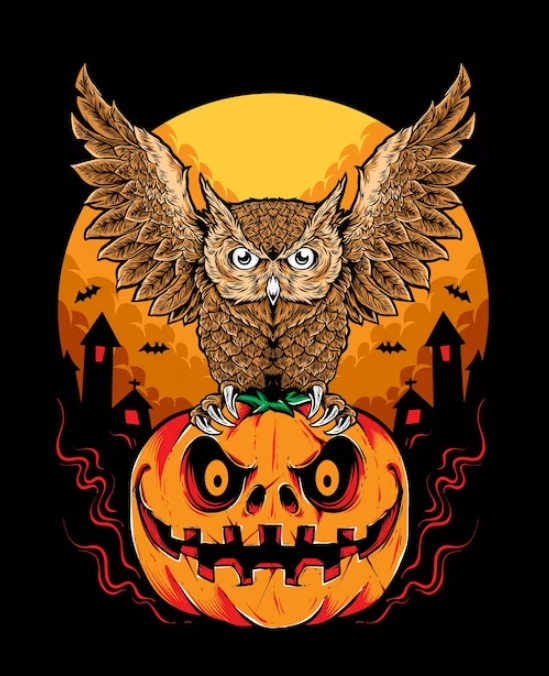
The Nocturnal Nature of Owls
The nocturnal nature of owls is a fundamental aspect of their charisma and contributes significantly to their association with the eerie and supernatural.
Here’s how their nighttime behaviors enhance their enigmatic image:
Nocturnal Habits and Darkness
Owls are primarily nocturnal birds, meaning they are most active at night. Their adaptation to darkness and exceptional night vision allows them to hunt and navigate in low-light conditions.
This nocturnal lifestyle aligns with the eerie and mysterious atmosphere of the night, making them natural symbols for the supernatural, where the line between reality and the unknown blurs.
Haunting Calls
Owls are known for their haunting and often eerie calls, which vary between species. These calls can range from soft hoots to sharp screeches and eerie wails.
The ethereal quality of owl calls, echoing through the darkness, has inspired superstitions and stories throughout history.
People have associated these sounds with mysterious omens, messages from the spirit world, or even harbingers of death.
The sounds of owls at night contribute to their charisma and reinforce their role as symbols of the supernatural.
Silent Flight
Another remarkable aspect of owls is their ability to fly silently. Owls possess specialized wing feathers and adaptations that reduce the sound of their wingbeats.
This near-silent flight enhances their aura of mystery, as they can approach their prey or move through the night with remarkable stealth.
The idea of an owl silently gliding through the darkness is evocative of a creature that traverses the boundary between the physical and the spiritual world, adding to their supernatural allure.
Owls in Modern Halloween Culture
Owls have become firmly entrenched in modern Halloween culture, and their association with the holiday has been significantly reinforced through various forms of popular media, including movies, books, and TV shows.
These pop culture references have amplified the connection and added layers of intrigue and allure to the image of owls in Halloween celebrations.
Witches’ Familiars
In contemporary portrayals of witches and the supernatural, owls are often cast as the familiars or companions of these spellbinding characters.
From the pages of popular novels like J.K. Rowling’s “Harry Potter” series, where Harry’s loyal owl.
Hedwig, plays a pivotal role, in the mystical, enigmatic owls accompanying witches in television series like “Charmed” or “Sabrina, the Teenage Witch,” these birds have become emblematic of the supernatural world.
Their portrayal as loyal, magical companions reinforces their connection to the mystical, making them essential in Halloween-themed narratives.
Mysterious and Wise Characters
Throughout literature, films, and TV series, owls frequently act as mysterious and wise beings.
Their iconic image as symbols of wisdom and the enigmatic resonates with creators and audiences alike.
In tales where the line between the known and the unknown is blurred, such as fantasy and mystery, owls often serve as guides, mentors, or custodians of hidden knowledge.
Whether found in the enigmatic, all-knowing owls of C.S. Lewis’s “The Chronicles of Narnia” or the wise, prophetic owl in L. Frank Baum’s “The Wizard of Oz,” these representations contribute to the magical aura of Halloween.
Owl-Themed Decorations
Owls have become synonymous with Halloween decorations. From owl-shaped lanterns and candle holders to intricately designed owl masks and costumes, these birds are featured prominently in the visual language of Halloween.
Their wide-eyed, haunting gaze and association with the supernatural make them fitting subjects for festive decor, adding an air of mystery and intrigue to the holiday’s aesthetic.
Children’s Stories and Animated Films
In the realm of children’s literature and animated Halloween-themed films, owls frequently play prominent roles.
These characters, whether portrayed as friendly, whimsical, or slightly eerie, contribute to the imaginative and whimsical aspects of the holiday.
Classic tales like “Spookley the Square Pumpkin,” featuring the wise owl Professor Hoot, or animated films like “Legend of the Guardians:
The Owls of Ga’Hoole” offers young audiences enchanting stories that feature owls as central figures in Halloween narratives.
Halloween-Themed Episodes
Television series, especially those with supernatural, fantasy, or horror themes, often incorporate special Halloween-themed episodes.
These episodes often feature owls as symbols of mystery or as part of supernatural occurrences, emphasizing the eerie and magical ambiance of the holiday.
Whether as messengers of otherworldly events or as mysterious omens, owls continue to captivate viewers’ imaginations, further cementing their association with Halloween.
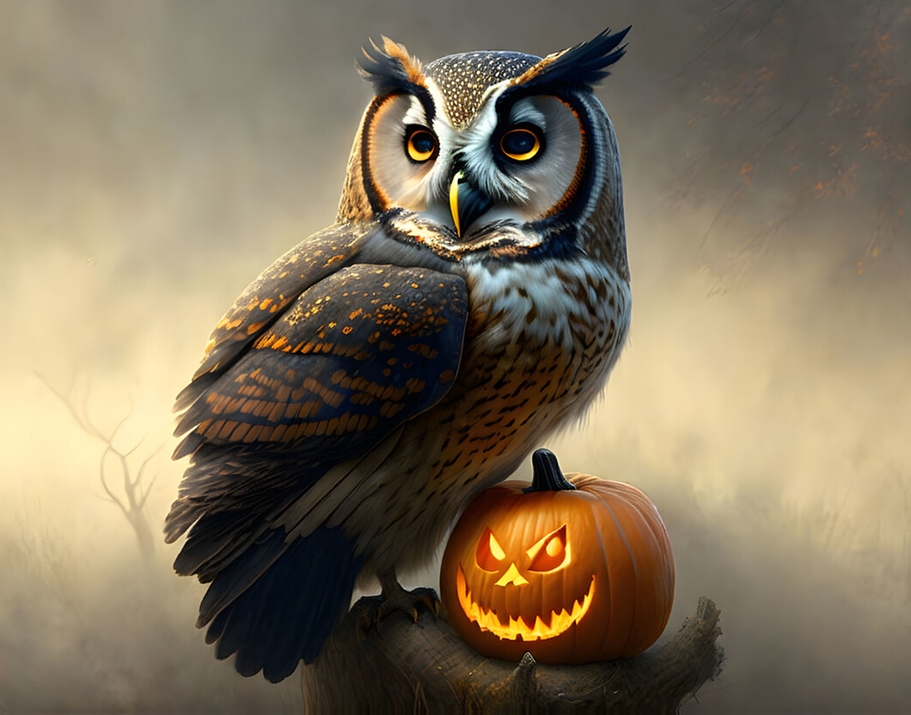
Superstitions and Folklore in Horror Films
Owls often make appearances in horror films and thrillers, where they are used to heighten suspense and invoke a sense of foreboding.
The haunting calls of owls or their sudden appearances in dark, atmospheric scenes contribute to the eerie and supernatural ambiance synonymous with Halloween.
Whether it’s in Alfred Hitchcock’s “The Birds” or more recent supernatural horror movies, owls are used to create a sense of unease, further strengthening their association with the holiday.
Halloween Literature
Halloween-themed literature often features owls as key elements of the narrative.
Classic stories and contemporary novels set during Halloween may incorporate owls to enhance the eerie, otherworldly atmosphere.
The owls’ nocturnal habits, wise persona, and association with the supernatural make them captivating figures in spooky tales perfect for reading by the flickering light of a jack-o’-lantern.
Widespread Mascot in Decor and Merchandise
Owls have transcended their roles in stories and media to become popular mascots for Halloween-themed products.
From costumes and decorations to candy wrappers and greeting cards, owl imagery is commonly used to represent the spirit of Halloween.
Their portrayal in these consumer goods keeps their connection to the holiday strong and omnipresent.
Halloween Festivals and Events
Owls are often featured in Halloween festivals, parades, and events worldwide.
These events may include live owl demonstrations, where people can see and learn about these majestic birds up close.
This interactive experience deepens the fascination with owls, making them an integral part of modern Halloween festivities.
Social Media and Memes
In the digital age, owls have found a place in social media, sharing and meme-fied in Halloween-themed content.
Memes, gifs, and digital art featuring owls with witch hats or in spooky settings have become popular among online communities, further embedding the image of owls in the collective consciousness of Halloween enthusiasts.
Halloween Decor
The use of owl motifs in Halloween decorations, costumes, and themes has become a widespread and beloved tradition.
Owls contribute to the eerie and enigmatic atmosphere of the holiday and are featured in a variety of ways:
1. Decorations
Owls are commonly found in Halloween decor. They are frequently depicted on lanterns, wall hangings, table centerpieces, and wreaths.
Whether rendered in spooky silhouettes or cute and whimsical designs, owl-themed decorations add an element of mystery and playfulness to Halloween settings.
Their wide, unblinking eyes and nocturnal nature are particularly suited for creating a sense of the supernatural.
2. Luminaries and Jack-O’-Lanterns
Owls often appear as lanterns or candleholders. When lit from within, these owl luminaries cast eerie, owl-shaped shadows, enhancing the ambiance of Halloween.
Additionally, carved owl designs on pumpkins or jack-o’-lanterns have become popular for those seeking unique and artistic ways to incorporate owls into their Halloween decor.
3. Costumes
Owls are a popular choice for Halloween costumes, especially for children and those who want to combine spooky and cute elements.
Owl costumes typically feature feathers, beaks, talons, and large, expressive owl eyes.
Whether it’s a child dressed as a “wise old owl” or an adult in an intricate owl costume, these outfits are striking and symbolic of the Halloween spirit.
4. Tableware and Party Themes
Halloween-themed parties often include owl motifs on tableware, such as plates, cups, and napkins.
These elements contribute to a cohesive and festive atmosphere for gatherings and are a fun way to incorporate owls into the celebration.
Owl-themed party themes and decorations can also extend to invitations, favors, and games, making them an essential part of Halloween parties.
5. Yard Decor
Outdoor Halloween displays often feature owl motifs, including owl-shaped yard ornaments and sculptures. These decorations can be paired with other spooky elements like tombstones, skeletons, and cobwebs to create a sinister and whimsical Halloween scene.
6. Front Porch and Entryway
Owls are a popular addition to front porch and entryway decor during Halloween, creating an eerie and whimsical ambiance.
Door wreaths featuring owl motifs and owl-adorned doormats and signs play a pivotal role in setting the stage for visitors and trick-or-treaters.
These decorative elements draw attention to the holiday’s spooky theme and invite guests into a world of enchantment.
Additionally, strategically placed owl statues and figures enhance the Halloween experience, greeting visitors with a touch of the mysterious and the supernatural.
Whether welcoming guests with open wings or subtly hidden in corners, these owl-themed decorations contribute to Halloween home decor’s overall charm and allure.
7. Candy and Treats
Even Halloween treats and candy packaging frequently feature owl themes. From owl-shaped cookies and cakes to candy wrappers and labels with owl designs, these treats add a delightful touch to Halloween celebrations.
8. Retail Displays
In the weeks leading up to Halloween, many stores and retailers leverage the widespread appeal of owls by prominently showcasing a range of owl-themed products.
This includes everything from costumes and accessories to home decor items. As a result, holiday enthusiasts have easy access to a plethora of owl-related items, making it convenient to infuse their homes and festivities with the enchanting spirit of Halloween.
The ubiquity of owl-themed products allows people to embrace the mysterious and whimsical elements of the season, adding a touch of Halloween magic to their celebrations.
Whether it’s owl-adorned clothing, spooky home decor, or charming party accessories, these items offer diverse options for those eager to embrace the allure of owls in their Halloween festivities.
NB: Owl motifs have become an integral and versatile part of Halloween decor, costumes, and themes.
Whether they are portrayed as wise, mysterious creatures or as playful, whimsical figures, owls are cherished symbols that enhance the visual and thematic experience of Halloween, helping to create a spooky and captivating atmosphere.
The Contrast: Positive Representations of Owls
In contrast to the eerie and supernatural associations of owls in Halloween culture, these enigmatic birds are revered in other cultural contexts as symbols of wisdom, protection, and good fortune.
Additionally, there is a growing modern appreciation of owls in conservation and nature circles, highlighting their importance in ecological and environmental contexts.
Positive Representations of Owls
In contrast to their eerie associations with Halloween culture, owls are revered in other cultural contexts for their positive attributes.
One of the most widespread and enduring positive representations of owls is as symbols of wisdom. This association can be traced back to ancient Greece, where the owl was closely linked to the goddess Athena, the embodiment of wisdom and knowledge.
The calm and observant nature of owls and their ability to see in the dark reinforced the belief in their wisdom. In various Native American cultures, owls are regarded as protectors and guides.
The Hopi people, for instance, believe that the Burrowing Owl safeguards them from evil spirits. Hindu mythology presents owls as companions to the goddess Lakshmi, symbolizing wealth and good fortune.
In Japanese folklore, owls are seen as creatures of luck and protectors from suffering.
These positive associations emphasize the multifaceted symbolism of owls across different cultures and their significance in conveying values like wisdom, protection, and good fortune.
Modern Appreciation in Conservation and Nature Circles
Beyond their cultural symbolism, owls are increasingly appreciated in modern times for their vital role in conservation and nature.
Owls are essential to ecological balance by preying on small mammals like rodents. Their presence helps control rodent populations, preventing overgrazing and the spread of diseases carried by these animals.
Conservationists and nature enthusiasts are drawn to the study and protection of owl species, recognizing the importance of these birds in maintaining the health of ecosystems.
Owl sanctuaries and rescue organizations have been established to care for injured or orphaned owls and promote awareness of their conservation needs.
Research projects focused on owl behavior and habitat preservation are furthering our understanding of these creatures.
Educational programs highlight the ecological significance of owls and emphasize the need to protect their natural habitats.
Conclusion
Integrating owl motifs into Halloween decorations, costumes, and themes is pivotal in shaping the holiday’s ambiance.
Whether portrayed as wise or whimsical, these nocturnal creatures have become a staple of the Halloween aesthetic, adding an element of mystery, enchantment, and playful spookiness.
Their presence in various aspects of Halloween culture, from decor to party themes, offers a versatile means of celebrating the holiday, catering to both the young and young-at-heart with a mix of eerie and endearing appeal.
As Halloween continues to evolve and enchant, the enduring popularity of owl motifs serves as a testament to the captivating nature of these birds.
Their symbolic connection to the supernatural and rich history in folklore and mythology make them an integral part of the holiday’s enchanting tapestry, ensuring that owls will continue to be cherished and celebrated for generations.
